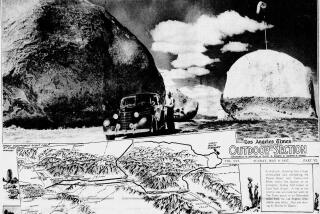Rocks and a Hard Place
- Share via
Two thoughts on the “Seismometers of the Gods” (by Michael R. Forrest, Palm Latitudes, Sept. 25):
Were Jim Brune’s precariously balanced rocks formed in that position, or did they shift there, perhaps because of an earthquake?
The Northridge temblor showed rather conclusively that earthquake forces can hopscotch over large territories, leaving one neighborhood unscathed while demolishing buildings a block away. Do Brune’s rocks prove that the Yucca Mountain site is stable, or only that the ground directly below the rocks is? Do they even prove that much, given the diagonal slicing effects noted Jan. 17?
I, for one, don’t feel at all reassured.
Robert Schmidt
Culver City
Forrest replies: Precarious rocks are indeed formed in place, but even if they were not, the desert varnish that’s found on the rocks can tell you how long they have been standing still.
The Northridge earthquake’s hopscotching was due to localized site effects including soil amplification and topography. As Tom Henyey of the Southern California Earthquake Center described hopscotching, “There was shaking everywhere in the L.A. Basin, but with pockets of anomalously strong shaking. And you don’t need unusually strong shaking to bring down rocks.”
*
Brune may refer to the precariously piled rocks he found in the desert near Victorville as “seismometers of the gods,” but they are probably calendars of the Indians. They appear to be piled so that people standing in a certain place would see the sun through the window and know what time of year it was--a small version of Stonehenge.
Brune’s stability theory is baseless and offers false encouragement to those worried about the proposed Ward Valley radioactive waste dump near Victorville.
He also ignores the new fault forming at a tangent to the San Andreas, heading across the Mojave Desert toward Victorville.
Radioactive waste could be put into glass containers and stored and monitored for leaks in warehouses. Or even better, it could be changed into inert components. The worst solution would be to bury it in the desert 20 miles from the Colorado River, cross our fingers and hope we don’t wind up polluting the drinking water of more than 20 million people in the Southwest.
Tom Freeman
Colton
More to Read
Sign up for Essential California
The most important California stories and recommendations in your inbox every morning.
You may occasionally receive promotional content from the Los Angeles Times.













